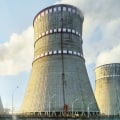Nuclear power workers are often referred to as 'Nuclear Nomads', 'Bio-Robots', 'Lumnizers', 'Glow Boys', 'Radium Girls', 'Fukushima 50', 'Liquidators', 'Atomic Gypsies', 'Gamma Sponges', 'Nuclear Gypsies', 'Genpatsu Gypsies', 'Nuclear Samurai' and 'Jumpers'. On average, they receive a lower annual radiation dose than flight crew and frequent flyers in 250 hours, who would receive 1 mSv. Don Hancock, Director of the Nuclear Waste Safety Program at the Southwest Research and Information Center, explains how nitrate salts in the absorbent of cat litter can interact with plutonium, potentially causing one or more 55-gallon drums stored in WIPP to rupture through a chemical reaction and ignite. To ensure safety, nuclear workers participate in accredited training programs that cover topics such as employee health and safety, radiation protection, and nuclear safety.
The Chernobyl nuclear reactor meltdown on April 26th, 1986 in Ukraine is an example of the potential consequences of inadequate safety measures. A 63-year-old man asked if his 33-year-old daughter's throat malignancy could have been caused by his radiation exposure while working at a nuclear power plant when he was 28. In a study of 407,391 nuclear industry workers from 15 countries, including the U. S., researchers estimated that 1%-2% of all deaths among nuclear industry workers could be attributed to radiation exposure. As an additional safety measure, all workers wear dosimeters to monitor their individual exposure levels.
The study found that occupational doses were higher among those employed in the nuclear industry for more than or equal to 15 years (111 mSv) and among workers classified as health physicists (56 mSv). Hundreds of thousands of military personnel and civilians in the United States have received significant doses of radiation due to their involvement in nuclear weapons tests and support for occupations and industries such as nuclear fuel and weapons production, uranium mining, milling and transportation of minerals. The analysis of Canadian nuclear workers (93.2 percent) provided no evidence of increased risk, and the risk estimate was consistent with the estimates that form the basis of radiation protection standards. Radioactive isotopes released in nuclear power plant accidents include Iodine-131 (I-13), Cesium-134 (Cs-13) and Cs-137. Studies suggest that at low doses, similar to those received by nuclear power plant workers, radiation risks are negligibly small.






